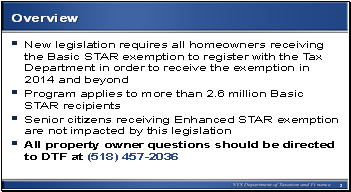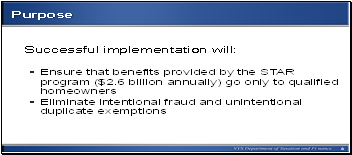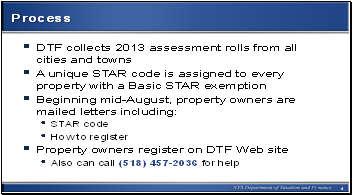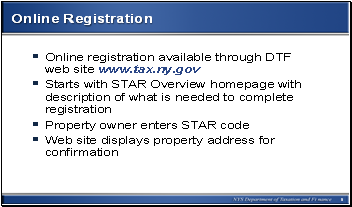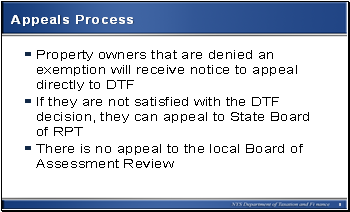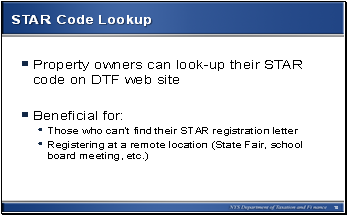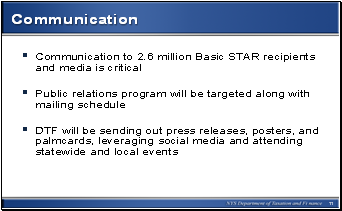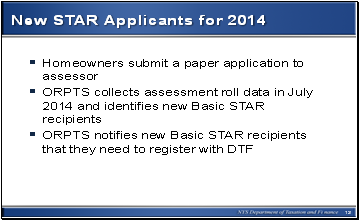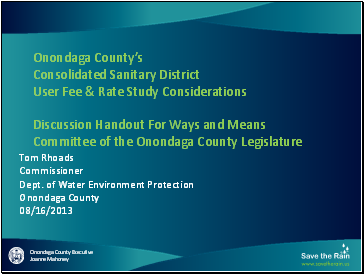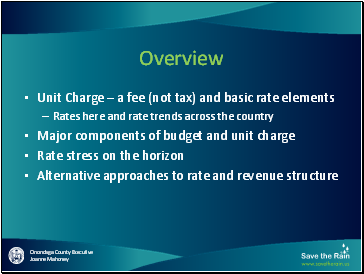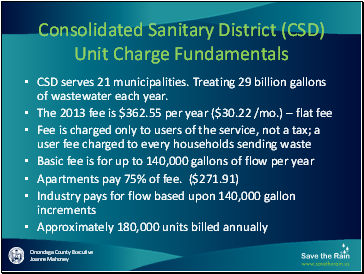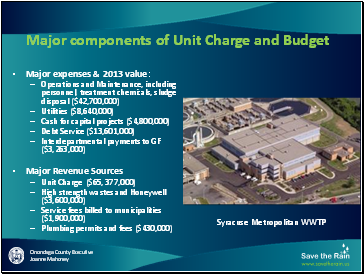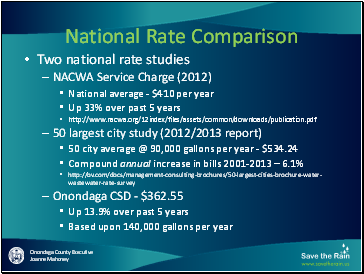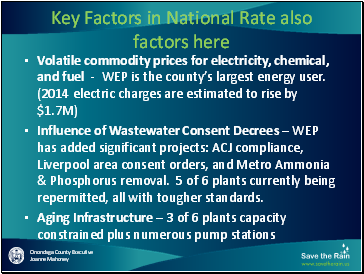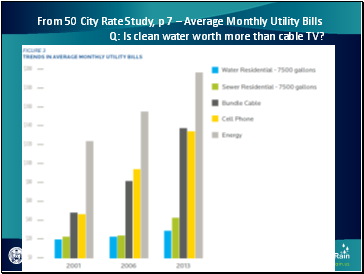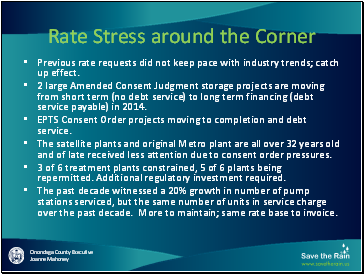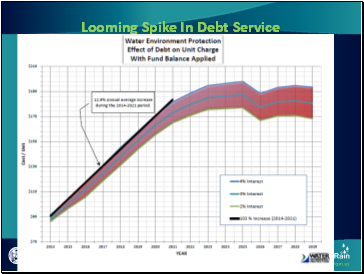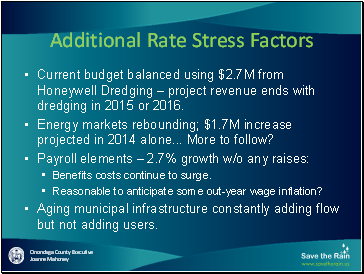ENVIRONMENTAL PROTECTION COMMITTEE MINUTES - AUGUST 14, 2013
MICHAEL E. PLOCHOCKI, CHAIRMAN
Members Present: Mrs. Rapp, Mrs. Tassone, Mr. Shepard, Ms. Williams
Also Attending: See attached list
Chairman Plochocki called the meeting to order at 9:03 a.m. A motion was made by Mr. Shepard, seconded by Mrs. Rapp to waive the reading of the minutes of the proceedings of the previous committee meeting. Passed unanimously; MOTION CARRIED. A motion was made by Ms. Williams, seconded by Mrs. Rapp to approve the minutes of the proceedings of the previous committee. Passed unanimously; MOTION CARRIED.
1. WATER ENVIRONMENT PROTECTION: Tom Rhoads, Commissioner
a. Authorizing the County Executive to Enter into a Contract with the United States Department of the Interior for the Operation and Maintenance of Stream Gaging Stations in the County of Onondaga
- Stream gaging stations used to measure flow and nutrients entering the lake; required compliance
- Consistent with last year’s resolution – pay 65% of the rate
In answer to Mrs. Rapp, Mr. Rhoads stated there was nothing different this year; all the same stations with a slight change in amounts - $87,720 last year and asking for $80,100 this year.
In answer to Mrs. Tassone, Mr. Rhoads confirmed that all the funds were used last year; fixed dollar agreements. Mrs. Tassone noted that the resolution states we are contributing the sum of up to $80,100.
Mr. Shepard asked if the small shed near the dog park was a gaging station. Mr. Rhoads state that is what they are like; can’t say if that specific shed is a gaging station. In addition to the gage, the stations record telemetry information on the flow for the streams that can be used by the engineers.
A motion was made by Mrs. Rapp, seconded by Mrs. Tassone to approve this item. Passed unanimously; MOTION CARRIED.
b. A Resolution Approving Various Green and Innovative Infrastructure Projects Located Outside the Amended Consent Judgment Area as Outlined in Local Law 1-2011 for the Purpose of Mitigating Inflow and Infiltration of Stormwater into the Consolidated Sanitary District Sewer System in and for the County of Onondaga, New York
Chairman Plochocki stated this is the final piece of the Suburban Green Infrastructure Program. In 2011 the previous Legislature allotted money for this program with disbursement of those funds going through the 2012 Legislature. During the budget process in 2012 money was again set aside for this project. We have voted on this item in various forms and have now reached the point where Commissioner Rhoads and others are coming back to us with a list of projects they feel are the best. Though not privy to the discussions, there have been many between the Legislature’s leadership and the County Executive’s office. All those in the appropriate positions are very happy with the selection.
c. A Resolution Authorizing the Issuance of $2,000,000 Bonds of the County of Onondaga, New York, to Pay the Costs of Various Green and Innovative Infrastructure Projects Located Outside the Amended Consent Judgment Area as Outlined in Local Law 1-2011 for the Purpose of Mitigating Inflow and Infiltration of Stormwater into the Consolidated Sanitary District Sewer System in and for the Onondaga County Sanitary District
Mr. Rhoads discussed items b and c together:
-
Item b approves the projects and item c authorizes bonding for the projects
-
Notice sent to municipalities within sanitary district to present applications for proposed green and innovate I&I removal projects; received $4m in applications - $2m has been authorized for these projects
-
Applications thoroughly reviewed and discussed - all good I&I removal projects but some did not contain the green approach, trying to change the way people think about and manage stormwater and our sanitary sewers, moving away from gray solutions; important for applicants to have green projects in area with frequent problems
Mr. Rhoads provided the following report noting the approved projects are listed in green:
Save the Rain Suburban Green Infrastructure Program Report 2013
The Save the Rain Suburban Green Infrastructure Program (SGIP) received a tremendous amount of high quality applications for the 2013 round of funding. Onondaga County Dept. of Water Environment Protection recommends funding for the following projects (highlighted in green below). Selection was based upon how green and innovative the proposed projects were as well as the ability to address inflow and infiltration (I/I). Areas within the sanitary district with a recent history of problems with flooding and sewer backups – such as the Town of Geddes, Town of Dewitt, and the Village of North Syracuse – were high priorities for I/I mitigation.
If possible, we recommend continued exploration of alternate avenues for future funding for reducing I/I with the additional projects proposed under SGIP 2013.
2013 Recommended Project Descriptions:
Town of DeWitt Willis Carrier Recreation Center Project
Funding not to exceed: $300,000
(Requested $400,000.00; Proposed Local Match 91% of entire rec. center development)
The Town of DeWitt is proposing to incorporate green infrastructure in the development of the Willis Carrier Recreation Center, a multi-use sports complex. The center will have stormwater management practices ranging from detention ponds, stormwater trenches, a porous parking lot, tree plantings, vegetated swales, and rain barrels. These green infrastructure practices will reduce the amount of stormwater runoff from entering Ley Creek as well as existing town stormwater and sanitary sewers located within the park itself. The town proposes removing 125,300 square feet of currently impervious pavement and constructing the new lot will be with porous asphalt. The construction of new parking lot will be done in Phase 1 and Phase 2 of the project, and the remainder of the complex will be completed in future phases.
Town of Geddes Bergner Road Green Interception Porous Pavement Project
Funding not to exceed: $210,000
(Requested $308,000.00 Proposed Local Match 17%)
The Town of Geddes proposes a green project for runoff reduction, installing a three foot wide strip of porous pavement along the sides of Bergner Road and a portion of Lakeland Avenue west of Bergner. In order to optimize runoff reduction in a cost-effective way, the remaining 20 foot width of standard asphalt pavement will be graded to direct drainage to the porous pavement strip. The existing drainage pipe along Bergner Road will be replaced with perforated pipe in a stone trench beneath the pervious concrete gutter. The catch basins will have grates several inches above grade, so they only take in water in large storms.
Town of Geddes Parsons Drive Green Median Project
Funding not to exceed: $400,000
(Requested $400,000.00)
The Town of Geddes proposes a green infrastructure project to retrofit the median along Parsons Drive with an underground infiltration trench. Curb cuts will be installed in the curbing around the north median and around the south median. Existing trees in the median will be left there along with additional landscape plantings resistant to frequent inundation to be added along the low area near the infiltration trench. An infiltration trench system will also be extended along Granger Road from Breakspear Road east to West Manchester to reduce flows going to the Bronson Road system. Perforated pipe will be installed in the infiltration trench along the side of the road, with catch basins near the intersections. The grates on these catch basins will be several inches above grade so they only take in water during large storms.
Town of Geddes Walberta Infiltration Basin Project
Funding not to exceed: $200,000
(Requested $201,000; Proposed Local Match 15%)
The Town of Geddes proposes a green infrastructure project at the Walberta Road School in the Westvale neighborhood. The school sits at a low point with now natural overflow route for stormwater drainage. Stormwater is diverted down Granger Road to the Onondaga County Trunk Sewer on Bronson Road. This trunk sewer currently surcharges during severe storms due to large amounts of inflow and infiltration. The proposed project would divert water to an infiltration basin for storage. The infiltration/detention basin is on Wegman’s property and the Town of Geddes is currently working to finalize a right-of-way agreement with Wegman’s. The project is expected to capture approximately 356,400 gallons of stormwater per year.
Town of Lysander Manhole Repair/Pipe Lining/Tree Planting Project
Funding not to exceed: $400,000
(Requested $400,000.00; Proposed Local Match 17%)
The Town of Lysander is proposing an innovative and green project including pipe lining, manhole repair and tree planting. The town plans to slip line sewer mains with cured in place pipe (CIPP) and epoxy coat 23 manholes included in the Indian Springs Manor sanitary sewer. In addition to the gray improvements, the town proposes to plant 42 additional street trees within the right-of-way.
Village of North Syracuse Green Interception with Streetscape Project
Funding not to exceed: $300,000
(Requested $400,000.00; Proposed Local Match 53%)
The Village of North Syracuse proposes a green streetscape project with porous pavers, tree planting and added green space. The proposed streetscape improvements include removal of impervious pavement surfaces and replacing approximately 4,500 square feet of that surface with grass as well as replacing 11,500 square feet with porous pavers. Under the pavers will be a perforated storm sewer system to collect and infiltrate runoff from Main Street and provide drainage for the pavers. Additionally, the village proposes to plant 92 native street trees will also be incorporated into the streetscape for water quality improvement and aesthetic enhancement to the corridor.
Village of Solvay Highway Garage Bioretention Project
Funding not to exceed: $110,000
(Requested $108,214.31)
The Village of Solvay proposes a bioretention project at their highway garage facility. The site contains poorly draining soils, so the proposed bioretention basin will be equipped with an underdrain system to improve drainage and promote pollutant removal through filtration. Some grading will also be required to create bioswales to direct runoff to the basin and modification to the existing retaining wall along the east side of the highway garage to allow for drainage.
Village of Solvay Trump and Power Streets Bioretention Project
Funding not to exceed: $80,000
(Requested $78,838.83)
The Village of Solvay is proposing a bioretention/rain garden project on village-owned land to capture stormwater and reduce inflow and infiltration (I/I) to the sanitary sewer. The project will install a bioretention system at a triangular piece of land at Power, Trump and Gillis streets and at a smaller piece of land immediately to the east across Gillis Street. Flow will reach these low-lying areas through curb cuts. These green practices will alleviate part of this volume via underground infiltration and evapotransporation processes in the bioretention areas.
Other Projects Submitted:
Town of Salina Sewer Separation/Disconnect Project
(Requested $70,000.00)
The Town of Salina Sewer Separation Project includes sanitary sewer removal and separation within Mattydale/Pitcher Hill Sewer District between Westview Avenue and Harford Road. This area has been determined a “hot spot” by the Onondaga County Department of Water Environment Protection and is an area of concern due to frequent maintenance and more importantly contribution to sanitary sewer overflow (SSO) concern within the area. The storm to sewer connection will be eliminated and all of this stormwater will be eliminated from the sanitary sewer system.
Village of Baldwinsville Pipe Lining & Manhole Repair Project
(Requested $400,000.00; Proposed Local Match 29%)
The Village of Baldwinsville proposes a televising, pipe lining and manhole repair project. The village will evaluate sewer mains in two areas with a history of excessive infiltration using remote television monitoring. When the most significant areas contributing to infiltration have been identified, a lining and repair contract will be prepared incorporating trenchless pipe lining technology to line and seal leaking sewer mains. Manhole structures will also be grouted and sealed.
Village of Camillus Manhole Rehabilitation Project
(Requested $185,535.00; Proposed Local Match 5%)
The Village of Camillus Sewer Rehabilitation Project aims to reduce inflow and infiltration (I/I) issues which adversely impact the Village sanitary sewers serving the “Eastern Village” area of Camillus. The project will include rehabilitation of sewer manholes located in the Village, including epoxy grouting to seal manhole walls and chimneys; replacement of manhole steps; raising/replacing manhole rims and covers that are at or below grade; installing manhole inserts on manholes that are subject to surface flooding; and replacing manholes with significant structure damage, missing bases.
Village of East Syracuse Pipe Lining and Manhole Repair Project
(Requested $400,000.00)
The Village proposes to make cost-effective improvements to the sewer system to reduce inflow and infiltration (I/I), utilizing innovative infrastructure methods to reduce runoff into the sanitary system including cured-in-place-pipe (CIPP) and manhole rehabilitation using chemical grout, spray on mortar, and epoxy resin liner coatings. These methods of improvement require little or no excavation or restoration.
Villages of Fayetteville & Manlius Joint Repair & Green Infrastructure Projects
(Requested $433,462.00; Proposed Local Match 15%)
The Villages of Fayetteville and Manlius collaborated in their application for SGIP funding for a joint innovative sanitary infrastructure rehabilitation project to remove inflow and infiltration (I/I) using green and innovative technologies.
The first part of the proposal includes conventional excavation/replacement and cured in place pipe (CIPP) lining to rehabilitate structurally unsound vitrified clay pipe (VCP) and VCP sewer with root intrusion in both villages. The joint project approach will increase opportunities for construction cost savings due to “economies of scale” and a single mobilization/demobilization, and reduce engineering design, bidding and construction costs.
The second component, the Pratt Lane/Feeder Street Green Infrastructure Improvements, seeks to continue the green streetscape enhancements through the Lower Village area with pavement restoration and integration of green infrastructure village-owned Pratt Lane and Feeder Street including porous asphalt and bioretention practices. This will extend the green streetscape from their 2012 SGIP project further through the village, creating a green corridor.
Village of Liverpool Pipe Lining and Tree Planting Project
(Requested $86,200.00)
The Village of Liverpool proposes a project that includes a combination of green and gray infrastructure technologies to reduce infiltration in the sanitary sewers and manholes along Hiawatha Trail and along the portion of Third Street between Birch Street and Bass Street. The green component of this project will be planting street trees within the right-of-way along various streets throughout the Village of Liverpool, capturing stormwater and providing aesthetic streetscape improvements.
Village of Solvay Bailey Street Pipe Lining and Manhole Repair Project
(Requested $281,518.20)
The Village of Solvay is proposing a pipe lining and manhole repair project. This will begin with using pressure concrete or epoxy methodology to rehabilitate deteriorating manholes. Manhole covers with holes will be replaced by water tight covers. Then repairs will be performed with cured in place pipe (CIPP) techniques. Sanitary or storm sewer cross connections, sump pump, driveway or roof drain connections that are found will be disconnected from sanitary sewers and connected to the existing storm sewer system.
Mr. Rhoads continued:
Mrs. Rapp asked if there was an opportunity to amend the list. She feels badly that the Community Development money was taken out of the Town of Salina because they didn’t write it correctly. This is a bad area. When you look at the dollar amount as compared to some of the other dollar amounts and the amount of good that this project could do in that community, she would be willing to talk about this. Mr. Rhoads responded that he understood. Mrs. Tassone stated that she would like to see some of the monies divided differently; less on some and more on some of the projects totally ignored.
Mr. Rhoads stated that he is allowed to entertain this discussion with the committee but the decision is happening at higher levels. During the dredging project, Honeywell is contributing millions of dollars per year for backflow received at Metro. We had asked to use $800,000 of these funds in the 2013 budget for I&I removal. This was a way in which areas where we have immediate problems could have been resolved via the use of green projects; understands there was only so much money to go around. He believes the course of action will be to see if we can found some of these projects with an I&I removal approach, while we have this funding opportunity in future budgets.
Mrs. Tassone asked who made the final decision on these projects. Mr. Rhoads stated the list was developed in close coordination with the legislature’s leadership and theirs. Mrs. Rapp noted that they needed to come back and talk to the committee.
Chairman Plochocki asked if the theory under the current proposal was to give a lot of money to a smaller number of projects. Mr. Rhoads responded that they wanted to makes sure that the projects were completed and met the goals of green and innovative. Several projects are good for I&I but manhole repairs and things such as this, do not reach the bar of being green or innovative. They would like to demonstrate that there are new approaches to resolving these problems. The request was very clear; looking for green and innovative solutions. Many of the solutions received have merit and would be good as pure I&I projects, however they are not green approaches toward these solutions.
Ms. Williams asked if those who had not been selected were notified as to why and what they could have done to improve their application. Mr. Rhoads responded that they would be; projects need to be approved by the legislature. He hopes they will move forward with the proposal provided. After they receive approval, feedback will be provided to the applicants.
Ms. Williams asked if they had an opportunity to add another project. Mr. Rhoads responded that this could not be done within the budget latitude allowed for this year. In answer to Chairman Plochocki, Ms. Williams confirmed that she was asking if they could include projects that were rejected. Chairman Plochocki stated that he believes Mr. Rhoads was stating that if we wanted to take a new project that hadn’t applied, the answer would be no.
Chairman Plochocki asked if it was Mr. Rhoads understanding that the projects could be amended. Mr. Rhoads responded that the way the legislation is written the projects must be approved by the County Legislature. The Legislature as a whole needs to come together on the priority projects and this then needs to be coordinated with the executive branch.
Chairman Plochocki asked if he was correct in assuming that because Community Development was a federally funded program, certain rules were put into place by the County, which created a delicate situation as to whether or not the County Legislature could change things and exactly what County Legislature approval means. Whereas, in this case we are talking about a different situation – it is a County program with County money and it is up to the County Legislature to approve the final list. Mrs. Berger responded that it is up the Legislature to approve the funding amounts but the decisions about the projects and infrastructure growing the district is up to the Commissioner. Under Article 11 of the Administrative Code, the Commissioner can make the final determinations as to what will benefit the district.
Chairman Plochocki stated he understands that it would be their decision as to what is within the certified sanitary district but his understanding is that all of these projects are located within the district. If this is the case, he asked Mrs. Berger if she thinks there are still parameters we would need to follow. Mrs. Berger stated the Commissioner develops maps and plans for the infrastructure changes that would extend the district. The resolution authorizes bonds for the projects, which would be repaid as district funds and there are checks over growing the district within Article 11, providing the Commissioner with certain controls of the district. Mrs. Berger stated that she could look into this further and would follow up. Chairman Plochocki stated it would be appreciated if she could.
Chairman Plochocki stated because there are so many unanswered questions, he is leaning towards not taking a vote on this item today. He asked the committee if anyone wanted to take a vote. There being none, it was agreed no vote would be taken.
Mrs. Tassone asked for an explanation on the Town of Dewitt project. Mr. Rhoads stated that there are a number of stormwater and sanitary sewers located within the park. With this project we will be removing impervious surfaces which will abate stormwater and have it naturally, in a greenway go into the ground. It won’t overtop the sanitary sewers in that area and cause inflow. There is a lot of old infrastructure in that area. We also have some drainage problems and flooding concerns along Ley Creek; some business flooded in 2011 in this area. The project will assist with an I&I issue and is tributary to our Ley Creek pump station where we have considerable amounts of I&I. This is a constrained pump station; extraneous flow in Ley Creek pump station and flooding in Ley Creek drainage district – this goes a long way in resolving both of those issues. These issues have been presented to use somewhat frost fully from business owners and their attorneys. Mrs. Rapp added that this was a really bad area. A few years ago the flooding was so bad that the manhole covers popped and people were going down the streets in canoes. This is a really good project. Mrs. Tassone agreed. Mr. Rhoads stated that this is using a green approach to resolve areas where they do have tremendous problems.
In answer to Chairman Plochocki, Mr. Rhoads stated that all of the projects are located within the certified sanitary district; doesn’t believe any of the projects submitted would stretch the boundaries or be outside of the district.
Chairman Plochocki stated the item would move onto Ways and Means.
Mr. Rhoads asked for the committee’s indulgence on another item – Clean Water Fair, September 7, 2103 from 9:00AM – 2:00PM at 650 Hiawatha Blvd., Syracuse, NY. http://savetherain.us/2013fair/
Mr. Rhoads stated that Chairman Plochocki was at the Clean Water Fair last year and reported that it was even better than the State Fair, according to his nephews. Chairman Plochocki noted that his nephews were three and six at the time. Two things that defined it as being better than the State Fair were the piece of pipe from the trunk line sewer and the fish species. The kids were amazed that these large tunnels were underground and were able to use a small net to pull out fish for closer examination. Mr. Rhoads added it was a great day and asked that they let people know.
Chairman Plochocki introduced Mary Kate Hartmann, as the new Executive Director for the Center of Nature Education at Baltimore Woods. The center is near and dear to his heart as it is located in his district and the town of Marcellus. It is one of our authorized agencies and they have been doing such an outstanding job that we increased their authorization last year; a rare thing to occur for an authorized agency. Patty Weisse was the director for many years and did an outstanding job. Ms. Weisse stepped down a few weeks ago and Ms. Hartmann is taking over.
Chairman Plochocki welcomed Ms. Hartmann and asked her to briefly discuss the invitation presented to them. Ms. Hartmann stated one of the largest fundraising events for Baltimore Woods was coming up on September 8, 2013 from 3:00PM – 6:00PM. It is our Environmental Chief Home Grown Event. It is a local Iron Chief Cook-off competition using produce from local farmers throughout Onondaga County and a portion of Madison County. The funds raised from this event are used to support the Nature in the City program. The program has been expanded this year from 11 schools to all 19 schools in the district. Programming is provided in grades K-2 and 4-6. The event is free to attend and a lot of fun - please come and join them.
Ms. Hartmann thanked the committee for their support of Baltimore Woods adding it is greatly appreciated and they truly enjoy carrying out their mission.
2. OFFICE OF THE ENVIRONMENT: David Coburn, Director
a. Informational - Emerald Ash Borer / Ash Tree Inventory Update
- Positive id of Emerald ash borer in Onondaga County – no surprise, would have liked a couple more years for preemptive work
- Due to proactiveness we are well positioned to face this challenge relative to many communities across the country and in NYS

-
Curve explains what was experienced in the Midwest; mortality pattern repeats itself in just about every community that has had the infestation occur, first 7 yrs.10% tree mortality, next 4 yrs. 90% mortality
-
Want to avoid being in steep part of the curve without being ahead of the game, trees would be falling down around you; hard to say where we are in the curve – hope to flatten out the curve so we don’t face a situation where we can’t keep up with the trees that are falling down
-
Spent time this spring on a system to achieve early detection of the Emerald ash borers arrival - helps them target resources in areas where infestations might occur; trying to slow the spread and avoid the steep part of the curve
-
Purple stars on map below indicate metrics of where the purple traps were located; because we created a taskforce of experts, educators, utilities, municipalities and other stakeholders we were able to obtain more traps than other communities – a number of them got about 20 traps we have 140; intended for early detection
-
Created a number of sentinel trees centered primarily in urbanized and city areas – for broader coverage created some sentinel tress in the perimeter area as well; this is done by girdling the trees - removing the bark from a certain area of the tree stresses the tree and acts as a lollypop for the beetles attracting them in, trees are then taken down in the fall and the bark is removed to look for tell tail galleries that show where the beetle is
-
Trap on Court Street Road contained positive id; put up by USDS APHIS, saw beetle July 5 and received positive id on July 29 – takes a while to get positive id’s; since that time have gotten positive id’s in Eastwood area along Kensington between Comstock and Westcott, several areas with suspected beetles need positive id, suspicious samples found by wasp nest in Lions Park - Baldwinsville area; using this system to target were efforts for slowing the spread will go
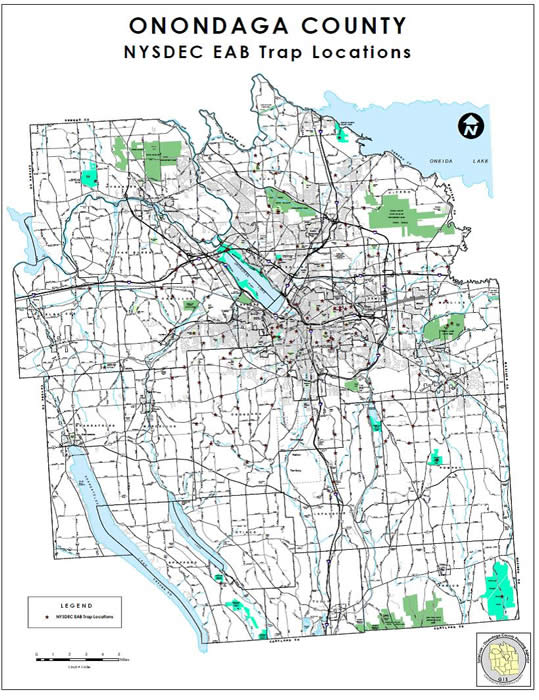
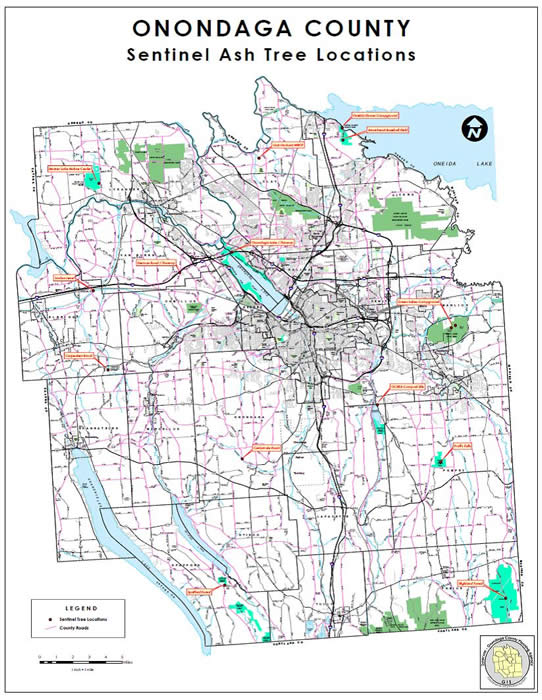
Mrs. Rapp asked if it would make since to hire people for inoculations. Mr. Coburn responded that it was something to consider but it doesn’t appear to makes since to create positions and pay benefits. Mrs. Rapp asked where the in-house number came from. Mr. Coburn stated the in-house number came from larger communities that have staff. If we put staff on, we could calculate what those costs would be. The team in Rochester has two or three teams of three inoculating. We have to look at the numbers. We are dealing with a lot more trees than Rochester; City of Syracuse has 8,000 street trees. Mrs. Rapp asked if Soil and Water would have some ability to do this. Mr. Coburn responded that they are acquiring some certification so that they will be able to do some application but we are talking about a lot of trees. It remains to be seen how many trees we will inoculate; would like to obtain the rest of the data to see our long-term plan. This does not preclude us from taking steps to move forward now.
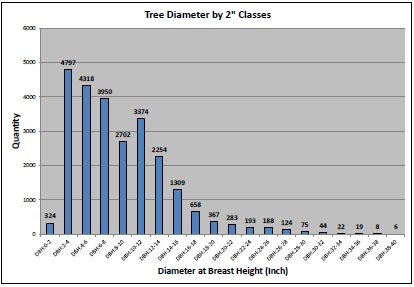
- Low end of tree size heavy – less expensive to treat; information invaluable in assisting with bids
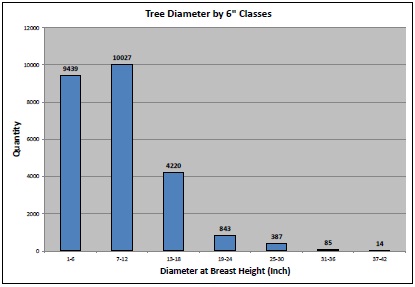 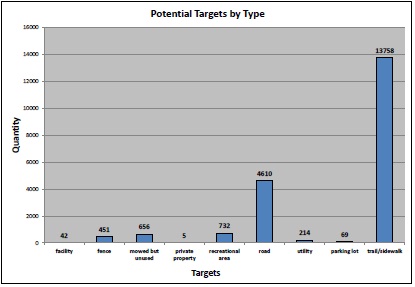
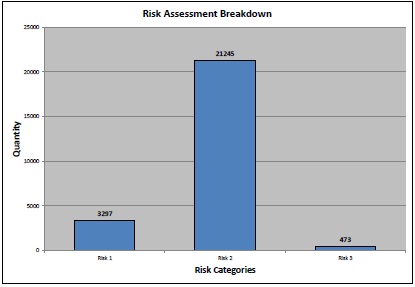
- Same information on County owned lands in pie chart format listed below
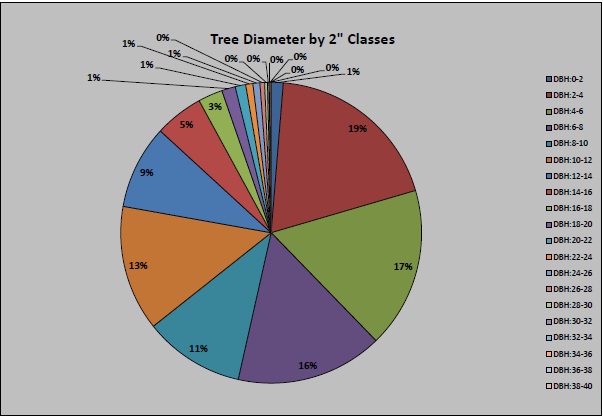
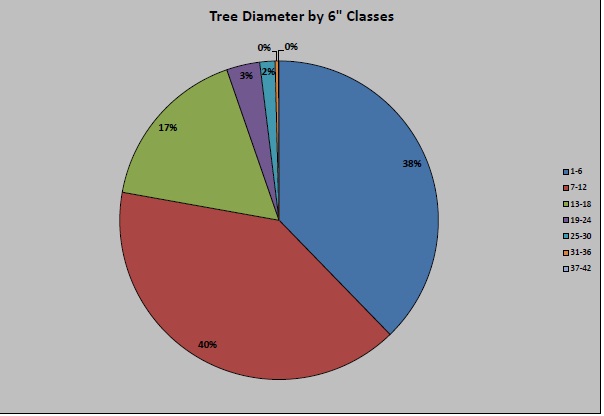
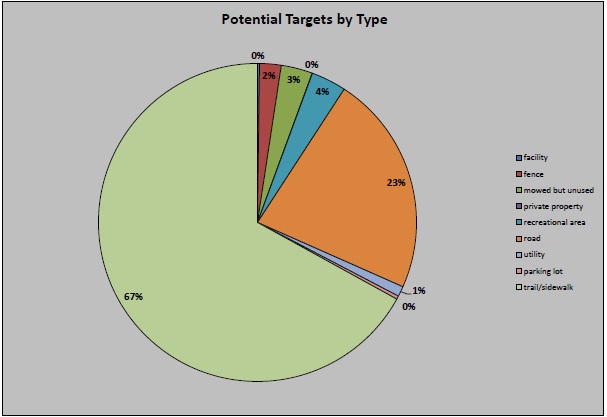
- Currently heavy percentage on trail/sidewalk – anticipate more will shift to road as inventory is completed
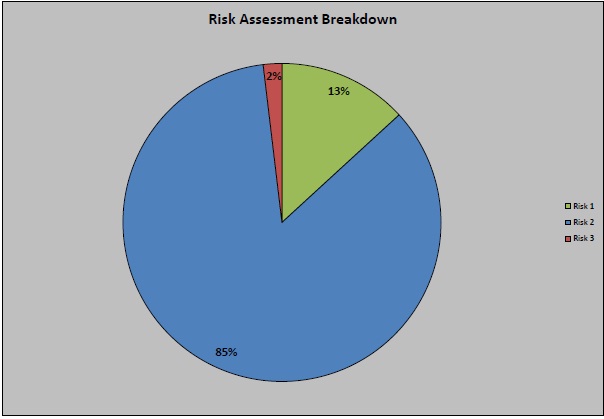
Onondaga County Ash Tree Survey |
Trees Adjacent to County Owned Property |
-
While inventorying County owned property also look across the property line for ash tree targets on private property - trees that could fall onto County property or County trees that could fall onto private property
-
Database extremely useful for strategy development
-
$250k appropriated in 2012 to begin implementation program; summarizing of this data paid for via these funds
-
Hope to start with Onondaga Lake Park and build a model for other parks and campuses; start with removal of risk level 3 trees, then remove or inoculation of trees in confirmed areas – targeting resources to slow the spread, then moving to risk level 2 trees – if trees have stem or canopy problems precluding them from inoculation makes since to take them down, next focus on small diameter trees
In answer to Mrs. Tassone, Mr. Coburn stated there are no guarantees that the tree will survive with inoculation. All we can go by is the success they have had in the Midwest, even with slightly infested trees. The inoculation actually kills the beetle. In some of the areas where you have infestation if you were to inoculate around the trees, it may help to kill the beetle, slow the spread and buy you more years in which to spread-out your removal costs. We are looking very hard at this strategy. When I say, there is no guarantee - there a number of other factors that affect these trees; have seen a number of false alarms. You really need to confirm that you are dealing with an infestation, before dedicating resources to try to slow the spread. The percentages are very good; optimistic it is a good investment if you are able to identify trees worth preserving.
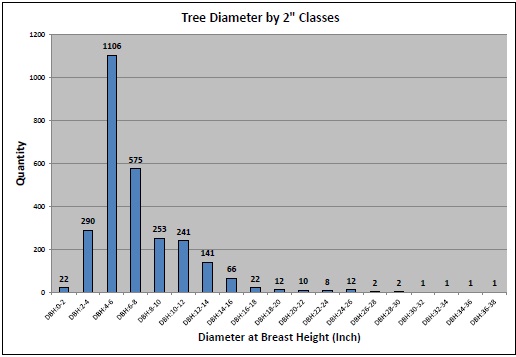
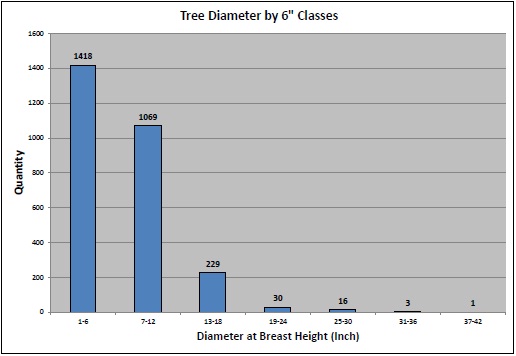
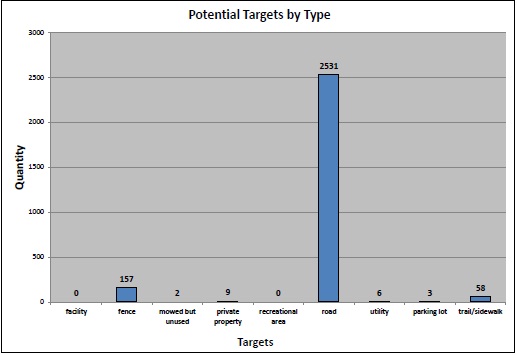
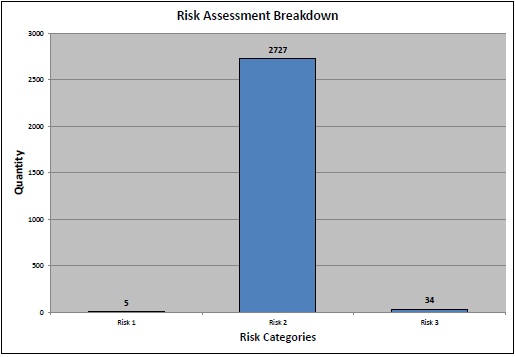
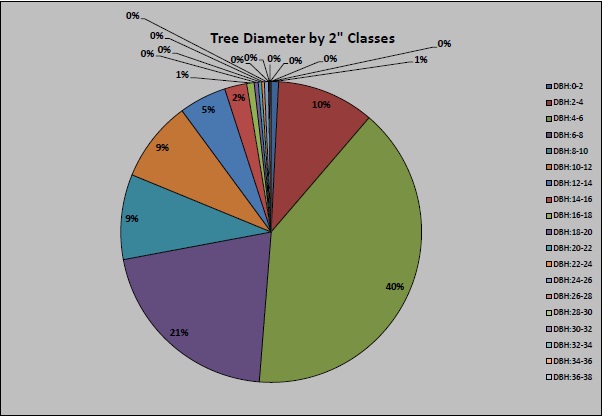
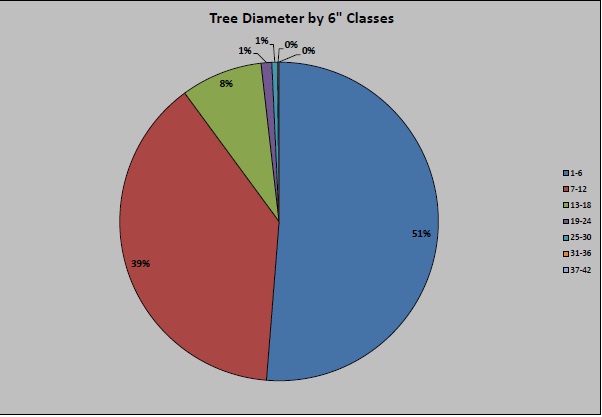
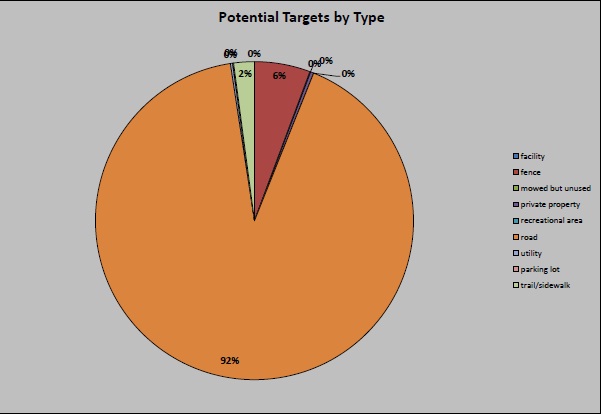
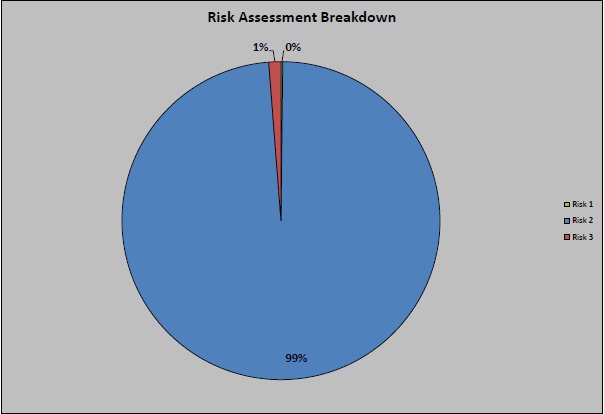
Mr. Coburn displayed a large GIS map for the committee to review noting the following:
-
Yellow dots represent ash trees in Onondaga Lake Park - over 4,400 in the park
-
Red dots represent risk level 3 trees
-
Purple dots represent all trees smaller than 4” diameter – very heavy concentration on one side of the park
-
Dark blue dots represent trees with severe stem or canopy damage
-
Helpful what-if questions can be answered using the database and GIS technology - asked Parks Dept. what the impact to the park and recreation use would be if we eliminated all of these trees
-
Parks Dept. has helped divide the park into 7 management units, based on use and intensity of use - would manage West Shore Trail differently than Willow Bay
-
We are utilizing our tool to develop a stagey to preemptively begin managing ash trees in Onondaga Lake Park
-
We are home to a rare species of Indiana bats hibernating in Jamesville Quarry, Long Branch Park is a major roosting area; due to Fish and Wildlife regulations can’t remove trees during the roosting season (April to end of September), removing trees in the winter isn’t a bad thing in terms of use for the park – pluses and minuses to this; trees could be taken down earlier if misting nets are used and no bats are found in nets over a period of time – expensive process, not worth spending money on as it is pretty certain bats would be caught in the nets
-
Early creation of taskforce has allowed us to be ahead of the game, also focal point for private residences, commercial and industrial business to go help identifying ash trees and providing positive id of the beetle
-
People are very interested – large number of calls, involves a lot of manpower but worth trying to determine whether or not there is an infestation
In response to Chair Plochocki, Mr. Coburn stated that the Willow Bay area has an extensive population of Ash trees. Cooperative Extension did a tagging event at park a while ago – placed purple ribbons with yellow tags on Ash trees to draw attention to the issue and help educate the public. The yellow tag contains Cooperative Extensions contact information.
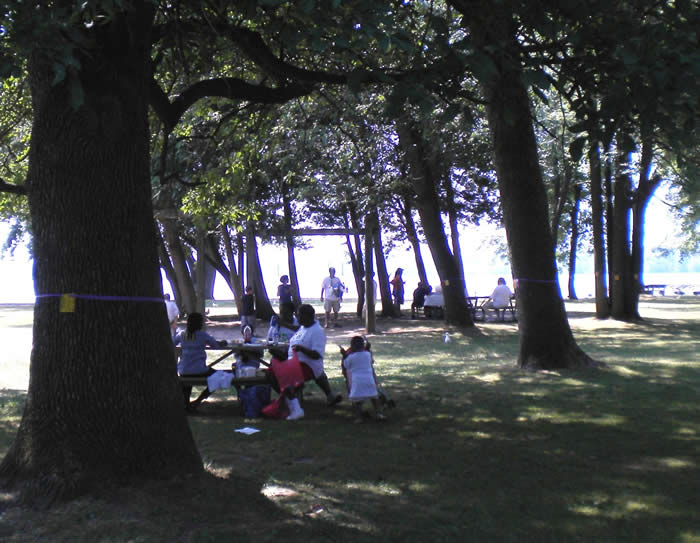
- Willow Bay area just off the lake
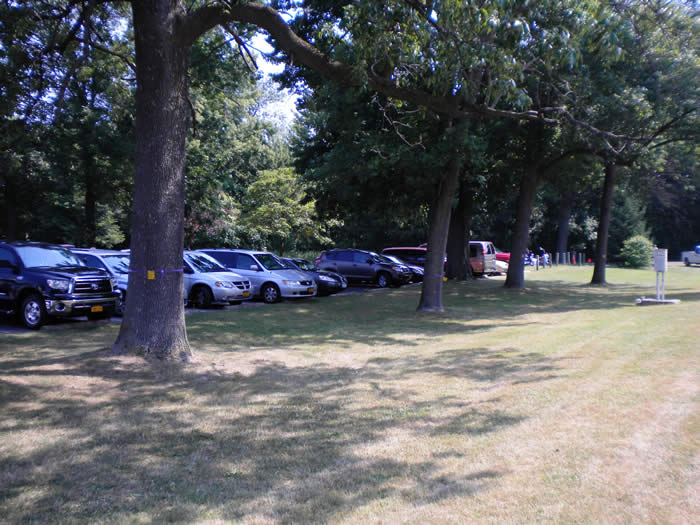
- Willow Bay parking lot – essentially all trees along the parking lot are Ash
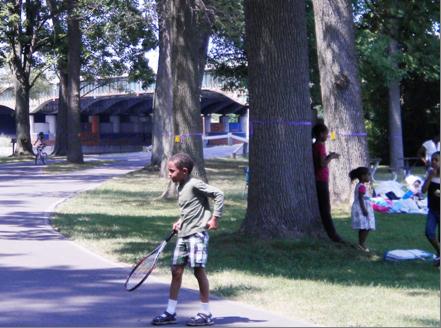
- Long Branch Bridge area crossing over the outlet – all but 2 trees in photo are Ash
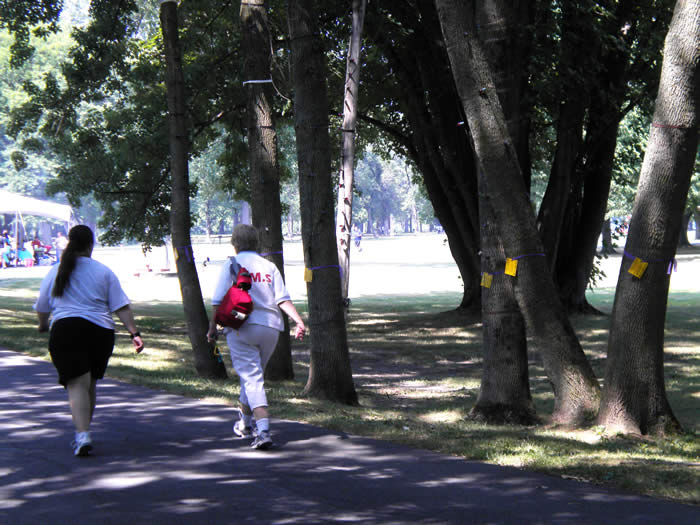
- Trail walking up toward Willow Bay
-
Willow Bay area would be devastated if all Ash trees were removed – would resemble a baseball field; may make since to consider canopy conservation, with gradual thinning of trees and replacement
-
Decisions will involve tradeoffs – better price if taking down all Ash trees; part of this is providing service to the community and preserving the character of the park; will probably recommend some kind of removal, replacement and inoculation over 10 yr. period – limiting liabilities but preserving recreational opportunities for the park
In response to Mrs. Rapp, Mr. Coburn stated it wasn’t practical to do one-for-one replacement of trees. Mrs. Rapp noted this would be very expensive. Mr. Coburn agreed, adding there are 4,400 trees just in Onondaga Lake Park. He doesn’t believe they will plant seedlings, as they suffer from mower disease and have a lower mortality rate.
In response to Mrs. Rapp, Mr. Coburn confirmed that they would not be planting Ash trees; would plant a very diverse crop of trees. They are working with the Parks department on the types of species they would like to plant. This would allow us to decide were replacement would start; probably some shift with replacement trees planted in areas where there are no trees now, while removals are done in other areas. When trees are removed, they don’t always fall as intended – don’t want plant new trees next to existing trees to be removed. There is a strategy in figuring out where, when and how to do replacement and removals.
Mrs. Tassone questioned what kind of time-frame we would be working with, noting they just came into the area. Mr. Coburn stated that we just positively identified them – the expectation is that they have been here for a few years, just not known. Melissa Fierke, MS, PhD from SUNY EFS will be undertaking a project to determine how long the infestation has been here and where it started. Our wild guess is that they have been here 3-4 years.
Mrs. Tassone asked if any trees had been killed because of this. Mr. Coburn responded that there are trees that are dying. The beetle was found in a trap on Court Street Road but the actual infestation appears to be on Franklin Park Drive. From the parking lot of a church on Franklin Park Drive, you can see trees that are in serious decline. Behind that, is a timbered area where there is serious thinning and a lot of woodpeckering – another indication that the beetle is there. The tree will start sprouting new braches at the bottom, its way of rejuvenating. This area has been impacted for some time; infestation is probably several years old. This is very difficult to find - even with the number of traps, sentinel trees and eyes they have in the field. The purple traps are starting to yield benefits; can’t get to them every week, as there are so many. They are checked 2-3 times per summer. About 25% still need to be checked, mostly in the southwest corner of the County. Part of the challenge is that some other beetles look exactly like the Emerald ash borer, to the layperson. It is important to get DEC or APHIS confirmation.
Chairman Plochocki stated for the record and to share information with the committee, he wanted to ask questions about cost saving measures, though he is aware of the answers.
Chairman Plochocki stated that Ash wood has a value to it and asked what the extent of the offsets would be from the trees removal. Mr. Coburn responded:
- Ash grown in timber stands is more valuable than open grown
-
Trees in Onondaga Lake Park are considered open grown; throw branches out at much lower levels creating many knots – less value, also tend to have objects in them such as nails - damaging to the expensive saws
-
Very apprehensive about using open grown trees; have technology to look for nails and such - some value in the larger trees
-
Mulching industry will take as much as we will give them, also talked with the biofuels industry – they all know we are looking hard at this question
-
Don’t’ expect to generate revenue, expect to realize a cost savings because of wood waste opportunities; current plan is to make sure people bidding on the new proposal sharpen their pencils when they give us a bid to reflect those cost savings; may not be as dramatic as we would like it to be
In answer to Chairman Plochocki, Mr. Coburn stated that we are lucky because Mark Burger, Executive Director for SWCD came to us from another position, where he was estimating timber values for the timber industry. He brings a lot of experience to the table.
Chairman Plochocki asked Mr. Coburn for his thoughts on waiting for trees to die and dealing with them at that time. Mr. Coburn responded:
-
We want to avoid getting into the situation where 20k or our 25k trees are dying in a 4-year period; someone would have to figure out how to cut 6k-7k trees per year and that is only half of the inventory
-
Maxwell Capstone students contacted municipalities across the Midwest for lessons learned early this year - without exception they said not to wait or you will end up in a situation where you can’t keep up
-
We are ahead of the curve, can begin bidding removals and treatments via the database – an invaluable tool; really places us ahead of other communities who are racing from one infestation to another - trying to keep up with it and not looking at it strategically
Chairman Plochocki stated based on the experience gathered from the Midwest by the Capstone students, if we wait until the trees die in years 8-14, trees will start dropping like flies everywhere, bringing down power lines and hitting buildings. Mr. Coburn reiterated the antidotal data says don’t wait, we wish we hadn’t.
Chairman Plochocki asked about letting trees along the trails stand, until they fall. Adding the odds of hitting a hiker is minimal. County employees could cut the fallen trees and push them to the side. Mr. Coburn responded:
-
Trees in the inventory are only those with targets; there are a lot of Ash trees that don’t have targets and are not in the inventory, they will be allowed to fall and let nature take its course
-
Intent is to manage inventoried trees in some form; may seem remote and there are trees that have died and fallen out there but there are two differences - the volume of trees falling all at once and the way in which they fall, instead of an occasional tree it will thousands and Ash trees fall over within a year or two of dying and tend to break of at the trunk and fall all the way over; when the Elm trees died you saw trunks standing for ten years, didn’t pose a risk and had a narrow drop zone
Mr. Coburn stated he received a YouTube video of a bus in Ohio that was hit by an Ash tree rolling down the road. Chances of this happening aren’t great but increase if you have 500 Ash trees along a road. A tree fall (not Ash) in a remote campsite area of Utah injuring a young boy where the forest service had put together stones for a campfire ring. The parents are suing the forest service for $1 million saying they should have known the tree was in poor condition. We are aiming to avoid these kinds of situations.
Chairman Plochocki asked about saving costs by not inoculating any of the trees. The Elms were not wiped out - a few remained and over the years will repopulate. Mr. Coburn responded:
-
Probably would be a small handful of trees resistant to the beetle; Ash trees in Asia, where they came from have more resistance and more predators, could be a day when more predators exist here but don’t exist today
-
Willow Bay is not inoculated and simply clear-cut or trees left alone, the situation would be very undesirable
-
Inoculation in certain areas, particularly infected areas – buys you more years in which to spread your removal costs out and to do replacement
-
Inoculation at the frontend is much less expensive than removal and replacement; trees need to be inoculated every 1-2 yrs. depending on the product used - now developing products for 3 yrs., trees grow every year so costs of inoculations increase yearly
-
Have to figure out what the balance is, guesses we will want use some combination of inoculation, removal and replacement, preserve trees in areas where it would be very beneficial to the community;
-
Trees make a big a difference in your energy bill - if we have a large healthy Ash tree providing shade to a County facility it may be worth keeping for a few years
-
All these trees will eventually die, all trees do; can consider planting replacements or eventually removing the tree as time goes on
- There is a cost for inoculation and removal but you are also buying a lot of good
Chairman Plochocki asked about the costs of inoculation and average tree diameter. Mr. Coburn responded:
-
Quotes at the upper end are about $10 per diameter inch if outsourced, starting to see these numbers come down; getting closer to the in-house cost of $5
-
Will have to see what the market is doing when we get involved in this
-
If we are able to develop in-house capability through Soil and Water, it would be at the lower end
-
Average diameter would change as the inventory changes – not that useful as there are areas with a large number of trees with a large diameter and then areas that have a large number of trees with a small diameter
Chairman Plochocki stated it would generally be the larger trees that we would want to save. Mr. Coburn agreed adding the intent is to take out small diameter trees before they become a more costly problem. As noted in the curve shown earlier, we have a very large number of small diameter trees. If you are talking about the departments issuing chainsaws and getting much of this work done, the feedback is that they can’t go very far; they are stretched pretty thin and resources are constrained. Even a 6-inch diameter tree has a very large canopy. Tree removal is one of the top 2-3 most dangerous professions in the country; don’t want to start issuing chainsaws to get things done. The idea of using inmates has also come up; don’t think we want to issue chainsaws to inmates. Mrs. Tassone agreed. Mr. Coburn stated there may be some opportunities in terms of managing wood waste and plantings and we will certainly explore them.
Chairman Plochocki stated to give the committee a rough since of the current costs it would be about $100 to inoculate a 10-inch tree, which must be done roughly every year. Mr. Coburn responded that it depends on the product being used; some have annual application. The pesticide of choice is injected.
In answer to Mrs. Rapp, Mr. Coburn responded that to apply the pesticide they drill holes in the tree and inject the product with large needles. The number of holes depends on the size of the tree; 10-inch tree likely to have 10 holes - product is injected and translocates through the tree. This product is labeled for 2 years; starting to see benefit for 3 years. They are working on finding applications in the Midwest that will go for 4 years. Inoculation could become increasing affordable.
Mr. Coburn stated that there is one other twist in New York State. There are individuals who have interpreted the regulations such that if you inoculate a tree it becomes regulated soiled waste. It then must be managed as soiled waste and go to a regulated facility for disposal.
In answer to Mrs. Tassone, Mr. Coburn confirmed the soiled waste regulation only applies in New York State. The regulation is being reviewed. If this is the way they are going to interpret it, unofficially, he has been told that they are looking at a beneficial use determination. This would allow the inoculated trees to be used for mulch, lumber and biofuels. The hope is that because the product is labeled for two years and not affective after two years, and by in large the product is gone at that point, they will then be able to determine it is not a problem. This is something that is hanging out there; whether or not it will have to be factored into the costs of inoculation is yet to be determined.
Chairman Plochocki noted that up to this point, the target area is 25,000 trees and we are about halfway done with the inventory. Mr. Coburn responded that we are about halfway done but he would not assume that it will be twice as many trees; just doesn’t know what it will be. Mrs. Rapp stated this is just on County property. Chairman Plochocki added it was only in targeted areas as well. Mr. Coburn agreed. Chairman Plochocki stated that without question this could millions of dollars’ worth of cuttings.
Mrs. Rapp asked if this affected all varieties of Ash trees. Mr. Coburn stated it affects all true Ash trees. Mrs. Rapp questioned if it would affect Mountain Ash. Mr. Coburn stated that Mountain Ash is not a true Ash tree; has orange berries and is not affected by this.
Mr. Coburn thanked the committee for their support noting it has made a big difference. He added they probably won’t be surprised if he comes looking for more support.
The meeting adjourned at 10:18 a.m.
Respectfully submitted,
KATHERINE M. FRENCH, Deputy Clerk
Onondaga County Legislature
* * *
PUBLIC SAFETY COMMITTEE MINUTES - AUGUST 14, 2013
KEVIN HOLMQUIST, CHAIRMAN
MEMBERS PRESENT: Mrs. Tassone, Mr. Dougherty, Mr. May
MEMBERS ABSENT: Mr. Ryan
ALSO PRESENT: Mr. Knapp, Mr. Andrews and see attached list
Chairman Holmquist called the meeting to order at 12:05 p.m. A motion was made by Mr. Dougherty, seconded by Mrs. Tassone to waive the reading and approve the minutes of the proceedings of the previous committee meeting; MOTION CARRIED.
Chairman Holmquist took the agenda out of order.
1. SHERIFF: Chief Balloni
Monthly Update on Status of:
c. Pistol Permits
-
Signed contract with vendor for technology; need check up front – not uncommon
-
Per resolution public notified of foil request received from emerges.com – resulted in hundreds of new request to opt-out; coming in faster than they can be entered, will delay any release they are able to make
-
Sheriff reached out to Law dept. and Sheriff’s Association, County Clerk reached out to County Clerk’s Association – foil requests are being denied statewide; Sheriff’s Association attorney strongly indicated requests can be denied as an unwarranted invasion of personal privacy – according to law shall not be limited to “sale or release of names and addresses if such lists will be used for solicitation and/or fundraising purposes”; since emerges.com is in that business it is a far inference to say the list will be used for this purpose; case law has been sustained
-
Reviewing all legal options, haven’t made a decision; strong indication names will not be released anytime in the immediate future
Chairman Holmquist asked if he was correct in the fact that not all pistol permit holders are listed on the computer, to begin with. Chief Balloni responded that was correct. They are all on the CHAIRS system, which is our criminal history system. All pistol permit holders are input into this system so that police are aware a pistol is on site when going to a residence. This is also the computer system we are using to log persons opting out. However, we now have hundreds and hundreds of forms that have not been input; believe this was a result of the media coverage. In addition, we have the Sheriff’s Association legal team indicating that perhaps we shouldn’t release any information. We will be consulting further with our Law department; Sheriff literally handed this to him, as he walked out the door.
Chairman Holmquist asked what list we would have once all the opt-out forms are processed and if the list will be taken from the CHAIRS System. Chief Balloni stated we could at least take the list of people who had opted out from the CHAIRS list. To do this correctly we need the new computer to be in position. In his opinion, there is no way to do this correctly, particularly in light of what this company will do with that information.
In response to Mr. Dougherty, Chief Balloni confirmed that all legally registered pistol permit holders were currently listed in the CHAIRS system. Mr. Dougherty asked if they decided to release this information, the list in the CHAIRS system would be exported into something with those people opting out then subtracted. Chief Balloni responded that was correct. Mr. Dougherty asked if this was something that in theory they could do automatically or if there was software that would allow for this. Chief Balloni responded that CHAIRS is a County created software system. Though not an easy thing to do, a program could be written to obtain this information.
Mr. Dougherty asked if the list of opt-out forms was also electronic. Chief Balloni responded that they are however, not everyone has been added to the system, as they are coming in fast and furious.
Mrs. Tassone asked how people were notified. Chief Balloni responded that it was done through media. The information is also listed on our website, where you can download the form.
Mr. Knapp thanked Legislator Dougherty for his previous resolution requiring this public notification. He has been amazed at the outpouring of media coverage. It was in the newspaper, constantly on the radio and on television last night, which has resulted in this public reaction. Chief Balloni added this is a very strong public reaction; their phones are ringing off the hook. Mr. Knapp stated this was something to feel good about.
In response to Mr. Knapp, Chief Balloni stated we must respond to any foil request within 5 days; simply says we have received the request and are looking into it. We then have an additional 20 days to say whether or not we will release the information and in what form. We are not jumping into anything. We are looking at all the options and researching what others are doing. At this time, it is very safe to say that the Sheriff is inclined not to release any of this information.
Mr. Knapp stated it would take more than 20 days to get all the exceptions entered. Chief Balloni responded that the answer has to be within 20 days. They can then take whatever time is reasonably necessary, to compile such as list.
Chairman Holmquist stated it seems like there are thousands of opt-outs. We have 45,000 permit holders; need to make sure accurate information is released, if the list needs to be released at some point in the future. Chief Balloni responded that the Sheriff has instructed that we make sure every opt-out form is input before releasing anything, should they decide to do so. Chairman Holmquist stated if there are 5,000 opt-outs, or whatever the number is, that is 5,000 opportunities to hit the wrong button and release someone’s name in error. Chief Balloni responded that they feel strongly about this; no one opting out will be released.
Mr. May asked if anyone had said they wanted their information to be included. Mr. Knapp responded that there was one person on television last night, saying he had nothing to hide and his name could be released. Mr. May asked if he specifically said he wanted to be included. Mr. Knapp responded that he didn’t say he wanted to opt-in, this goes back to the SAFE Act, it should have been written to opt-in as opposed to opting out. Chairman Holmquist added the people that wrote the law did not feel that way.
b. Special Operations Facility
- VIP Structures handling needs assessment, process could take a couple months
d. Correctional Health
- In the middle of RFP process – not free to comment on this
In answer to Mr. May, Chief Balloni stated the response deadline has passed. There is a large committee of professionals reviewing the responses.
Mr. May asked if there was a deadline as to when a vendor will be selected. Chief Balloni stated the RFP contains an expected date. However, we want to take whatever time is necessary to evaluate the information correctly. This is a major decision; want everyone to have a good look at the information. The process is ongoing. Mr. May asked what the expected date was. Mary Christiano responded that August 26 is the date in the RFP but it’s not concrete that we have to decide. Mr. May stated he understood. Chief Balloni added they certainly want to start working with whatever vendor is selected as quickly as possible.
Mr. May noted we have extended our time with the current vendor. Chief Balloni responded that we have done the contract work on this; doesn’t know if it has all been completed.
a. New Mental Health Unit at Justice Center
-
RFP went to Purchasing dept., have a number - means it can go out; should be in the process of selecting an architect/engineering firm to do the design
-
Will work with both State and Federal Commission of Corrections; Federal Commission will advise on best practices; State Commission has regulatory authority over us
-
Note – last time the initial bldg. was built State Commission reviewed plans then disallowed some things after they were built
In response to Mr. Dougherty, Chief Balloni stated disallowing the space meant we were not allowed to use the room. The restriction is still in place. In answer to Mrs. Tassone, Chief Balloni stated they are using the room for alternate purposes. Chief Balloni added that even if the State Commission tells them they can do something, they are never quite sure. The Commission is not easy to work with. They are a regulatory independent authority with no direct report to anyone, except themselves.
Mr. Dougherty stated this was ridiculous and asked if the disallowed rooms are still useful to them. Chief Balloni responded that they have repurposed them; they have to, as the population, numbers are very high. He simply pointed this out to show that even though we work with the State Commission, it is possible for them to change their minds at the end of the line. Mr. Dougherty stated his point was, if it was now worth reviewing with the state to see if they had changed their mind before making any further changes to that building. Chief Balloni responded that it was not, they have repurposed the space and it’s not enough space to do the job that needs to be done.
Chief Balloni continued:
Mr. May asked if the Behavioral Health side of the RFP was exploring whether this will be a county solution or something more regional in nature, from a space standpoint. Chief Balloni responded that they are certainly looking at those options from a space standpoint. Mr. May asked if this was part of the RFP. Chief Balloni responded that it is not specifically spelled out in the RFP, for a number of reasons.
Mr. May asked how this could be thoroughly explored without being in the RFP. He thought it was relatively clear that we wanted to look at whether or not this capability would benefit other counties. It is a specialized application and would take a burden off them and perhaps benefit Onondaga County. Chief Balloni responded that we have been going to the other counties and talking to them. In terms of the specialized application for Behavioral Health, one of the things we learned from the Federal Commission is that for purposes of the best treatment individuals need to be as close to home as possible; would then get visitation from family, friends and so on. We were more looking at what to do with the available cells, depending on how we build it, whether or not we could fill it. He thought this was the direction they had been looking, based on the Commission’s report.
Chief Balloni stated they are looking at the same thing through a different glass; looking at it in terms of space, as people with these issues are much better off staying in their community, if possible. Even in our scenario, there will be people that need continuous medication and things that we can’t provide in our institution, even with upgraded capabilities. There will be people that will end up in mental hospitals. In those cases, they are always taken far away from home, which is not a good thing. Most of the people in our various jails throughout the county can stay in their community and receive proper treatment and assistance. We are looking at what can be done with the extra space and what can we report back to this committee regarding that; how much regional demand is there and could we make this a regional facility. He thought that was the direction. Mr. May said he did not but he is only one person.
Mr. May stated he believes the RFP gives them opportunity to explore those options, should we wish to pursue it. Chief Balloni agreed saying the RFP gives you an ability to contract for specific services. In general, the RFP is what we are building, a Behavior Health unit. Pretty much everyone agrees the number of beds needed is about 100.
e. Amending the 2013 Budget to Accept State Homeland Security funds for the Onondaga County Sheriff’s Office and Authorizing the County Executive to Enter Into Contract to Implement this Resolution ($72,500)
In answer to Mrs. Tassone, Chief Balloni stated the committee of law enforcement officials includes Town, Village and Sheriff Officials; decide as a group what the highest priorities are. All the needs are real, it is just a matter of prioritizing and being fair; objective is for everyone to have the equipment needed to do the job safely.
In answer to Mr. Dougherty, Chief Balloni confirmed these funds were for terrorism prevention. Only certain items are acceptable for purchase under the grant guideline.
Mr. Dougherty questioned the portable refrigerator/freezer for Dewitt Police. Chief Balloni responded this kind of thing could easily be for the storage of evidence; biological evidence is put into cold storage. He doesn’t have the specifics but is making an educated guess. Mr. Dougherty stated he was glad he asked as he could only picture one type of portable refrigerator/freezer. Chief Balloni added he was certain you would not be eating for drinking anything out of this particular unit.
Mrs. Tassone asked if this was done yearly, with each agency requesting funds for a specific use. Chief Balloni confirmed that was the case. Mrs. Tassone asked if most of the agencies answered. Chief Balloni stated they did, adding most agencies want to participate.
Chief Balloni stated they received a Lifepac 15 for Air 1 today; $26,000 piece of equipment. They were able to reallocated funds to this from leftovers of a grant such as this. There is a chance that an agency may say their needs have changed and they don’t need their money. The committee would then reallocate those funds according to what is acceptable within the grant guidelines.
A motion was made by Mr. Dougherty, seconded by Mr. May to approve this item. Passed unanimously; MOTION CARRIED.
2. EMERGENCY MANAGEMENT: Kevin Wisely, Commissioner
a. Accepting Homeland Security Funds from the State Homeland Security Grant Program for the Onondaga County Department of Emergency Management, and Authorizing the County Executive to Enter into Contracts to implement this Resolution ($261,000)
A motion was made by Mr. May, seconded by Mrs. Tassone to approve this item. Passed unanimously; MOTION CARRIED.
The meeting was adjourned at 12:33 p.m.
Respectfully submitted,
KATHERINE M. FRENCH, Deputy Clerk
Onondaga County Legislature
* * *
COUNTY FACILITIES COMMITTEE MINUTES - AUGUST 14, 2013
JUDITH A. TASSONE, CHAIR
MEMBERS PRESENT: Mr. Dougherty, Mrs. Rapp, Mr. Andrews, Mr. Shepard
ALSO PRESENT: see attached list
Chair Tassone called the meeting to order at 10:33 a.m. A motion was made by Mr. Andrews, seconded by Mr. Shepard to waive the reading of the minutes of the proceedings of the previous committee meeting; MOTION CARRIED. A motion was made by Mrs. Rapp, seconded by Mr. Shepard to approve the minutes of the proceedings of the previous committee meeting; MOTION CARRIED.
1. TRANSPORTATION: Brian Donnelly, Commissioner
a. Authoring the County of Onondaga to Accept Real Property Obtained by the State of New York Relative to the North Burdick Street, C.R. 94, Over the Erie Canal Bridge Replacement Project, PIN 375376
-
NYSDOT - bridge replacement project on N. Burdick Street in Town of Manlius over Erie Canal – County road – required to obtain right of ways to comply with slip, better drainage
-
Asked County once right of way acquired and approved drainage, to allow the right of way; no issue and no cost to County; to accept right of way, have to have legislative authorization
A motion was made by Mr. Dougherty, seconded by Mrs. Rapp, to approve this item. Passed unanimously; MOTION CARRIED.
b. Amending the 2013 County Budget to Fund in the First Instance 100% of the Federal Aid Eligible Costs at a Maximum Amount of $16,000 for the Right of Way Acquisition Phase of the Willis Avenue Bridge Over the CSX Railroad Project, PIN 3754.26 and Authorizing the County Executive to Enter into Agreements to Implement the Intent of this Resolution ($16,000)
- Fed aid project - replace Willis Ave bridge in Town of Geddes; need 3 temp easements to access under the bridge
-
Total cost is $20,000; $4,000 local secured in work plan; Fed aid funding so need authorization to spend $16,000 in advance and get reimbursed
-
Temp easement – have 4 locations and 3 property owners for access onto railroad land to bring in heavy equip
-
Span of 8 – 10 months to keep open
-
Any real-estate negotiations for right of way on fed aid projects is done by NYSDOT – generally temporary easement is 10% of what a permanent easement would be; assessed at $20,000
-
Land owners: Honeywell, Church and Susquehanna Railroad & IDA; 4 breaks but 3 property owners
-
Paying to use property; no owning, no takings; guarantee access to piers and under bridge for entire period of project
-
Fairly sizable easements; way railroad is sloped - it is a long expanse to move equip in
- Determining if IDA has control or Susquehanna railroad; working with IDA
Mr. Dougherty asked if there is damage to the property, will the County be liable for it. Mr. Donnelly responded that liability is always an issue. Generally the temporary easement protects the County from the damage but if it is deemed to be a permanent harm to the property (would refer to Law), but think they would come back with a claim. The whole idea of getting the temporary easement is to explain what is going to be done, how the property will be accessed and paying for the right to guard against getting into any legal action.
Mr. Donnelly replied to Mr. Andrews that it is just for the length of the project. The tracks are owned by CSX but the bridge is owned by the County so DOT has to get in to do the pier work. Once it is done, Mr. Donnelly believes they will not have to be back there for another 30 – 40 years.
A motion was made by Mrs. Rapp, seconded by Mr. Dougherty, to approve this item. Passed unanimously; MOTION CARRIED.
c. Amending the 2013 Onondaga County Budget to Provide For the Local Match Dollars for the Onondaga Lake Canalways Trail, PIN 375355 ($200,000)
d. Amending Resolution No. 148-2007 to Increase the Authorization to Pay in the First Instance 100% of the Federal Aid Eligible Costs by an Additional $800,000 for the Construction and Construction Inspection Phases of the Onondaga Lake Canalways Trail, PIN 375355 ($800,000)
-
Onondaga County Canalways Trail – under construction of section that connects West Shore Trail to State Fair lot
-
-
2007 – DOT secured federal and non-fed funding totaling $3.5 million; non-fed funding from find money through Pepsi; project to bid in 2012; bids were $400,000 – $450,000 higher than what was secured in 2007
-
Had enough money to award bid and get under construction
-
Since building through waste beds, wanted to get into project to see challenges before securing additional fed funding
-
Challenges: soil stabilization and pile depths for bridge across 9 mile creek resulted in change orders for $180,000
-
Soil stabilization and desire to make sure individual stay on the trail – need to increase rail to tune of $250,000
-
$800,000 in fed; this source not eligible for state so it’s 20% share; $200,000 of County funds will be surpluses from North Street Project completed last year (Jamesville Road to 173 in Town of Dewitt); budgeted $200,000 more but asphalt pricing never went as high as anticipated; capital project, have bonded funds
-
Bridge installed yesterday - begin paving; limited work during Fair with no disruption; work on outer parts of trail away from Fair parking; paving in September and anticipate substantial completion by mid to end of October
-
Honeywell has a lot of work in proximity to trail – coordinating with them to minimize potential conflicts; don’t want to open trail then have to close
-
Fed funding is CMAC (Congestion Mitigation and Air Quality) funding - available since mid 1990’s because of air quality issues; have $1.5 mil available; only need $800,000 – 20% match; not eligible for Marcheselli funding - 15%
-
Eligible for fed highway funding under CMAC because it is alternate transportation; not motorized transportation; other projects include walking routes or bike routes - no air quality issues, and may reduce carbon monoxide in atmosphere
A motion was made by Mrs. Rapp, seconded by Mr. Shepard, to approve item 1c. Passed unanimously; MOTION CARRIED.
A motion was made by Mr. Shepard, seconded by Mr. Dougherty, to approve item 1d. Passed unanimously; MOTION CARRIED.
e. Authorizing the Sale of County Highway Property Located in the Town of DeWitt to Donna Fergeson and James Burry ($400)
A motion was made by Mr. Dougherty, seconded by Mrs. Rapp, to approve this item. Passed unanimously; MOTION CARRIED.
2. CNY ARTS: Stephen Butler, Executive Director
a. Amending the 2013 County Budget to Make Funds Available to CNY Arts for Distribution to Musical Associates of Central New York, Inc. ($75,000) (Attachment No. 2 – Report on Symphony)
-
Moving money from contingency fund to Symphony; working w/Symphony and others to oversee startup of operation
-
Ended first year; started in Oct.; generated $1.1 mil in income; County funding was less than 20% of that
-
Ticket sales and service fees – hired by colleges or universities to perform
-
Ended in black; assets available to them; biggest expense is musician fees which may go down with more musicians; job people in; lot of musicians left after SSO folded
-
Good news – hired Executive Director; Syracuse native; happy to see they’re starting to spend money on marketing
-
CEO not a volunteer board member who has street credits – $1.1 mil first year so all things look possible
Mrs. Rapp asked if they are working with the CVB. Mr. Butler responded he believes they are. There is a Video Games Concert the Symphony is doing with the Landmark. The Symphony is unchained from any one performance venue which saves them money, and allows them to work in churches and regionally. The Symphony has partnered with the Landmark to do the Video Games concert that will run while the Everson is doing the Video Games exhibit. They are all working with the CVB on putting together packages to get families from out of the area to the museum and concert which will require them staying overnight.
Mr. Butler:
-
Announced full season for next year; hired Pops Director/Conductor – out in CA but from Syracuse; come in to manage Pop series
-
Good venture; almost through startup phase and moving to full-fledged organization; budgets over $1 mil; did 80%
-
When symphony folded, musicians moved to Buffalo or Boston; still jobbing people in; as this Symphony takes over, more and more people from region will join the collaborative; this is the regional Symphony
Mr. Dougherty stated it will be good to see more pairings like the Everson and other events in the area. The Symphony could get into some of the concert series the towns do, or even Memorial Day or 4th of July parades; it would raise a lot of publicity. Mr. Butler commented that the Symphony usually does the fireworks but these things are planned out a year in advance; this Symphony was flying by the seat of their pants last October. They want to be more relevant to the community. Mr. Dougherty said that was the problem before. The Symphony was a thing someone could do but the publicity was sparse. They did not plug into things that were drawing in other people. Mr. Butler stated it is a change in thinking. They have partnerships with St. Paul’s, they are working with Chamber Music Society, and they are sending out small groups of musicians to play at different venues.
Mrs. Rapp asked if the Video Games concert is partnered with other groups. Mr. Butler responded yes but he knows of only the one since it came through his door.
Mr. Butler commented it is good that they are thinking like this. They now have an Executive Director that ran music festivals, is more accessible and is full time. They will also be partnering with the Syracuse Opera to share administrative costs and the box office. Chair Tassone said it is a great job.
A motion was made by Mr. Dougherty, seconded by Mrs. Rapp, to approve this item. Passed unanimously; MOTION CARRIED.
3. PARKS: William Lansley, Commissioner; Nate Stevens, Administrator
a. Lights on the Lake Report (Attachment No. 3)
Mr. Lansley:
-
Report attachment A – shows where dollars go; approx. 180 displays; each year select group of displays that are deteriorated or beyond rehab are sent out - sand blasted/repainted/rewelded – each year in $25,000 range
-
Parks operates, makes deposits, revenues are contractually for Galaxy – they reimburse Parks for expenses plus
-
Last page shows dollars: operations $266,000, revenue $336,000; guaranteed $320,000 dollars and split of revenues; split revenue increase w/Galaxy; $16,000 this year
-
Operation expenses from 2011 - 2012 dropped
-
LED bulbs last longer, so less replacements; less expensive to operate
-
Report attachment B – Dec. 2011 kilowatt hours was $96,000, in 2012 $74,000; 23% decrease; expenses for electricity dropped from $12,000 – $10,000; operate lights - late Nov. through first week+ in Jan.; move towards LEDs
Mr. Dougherty asked since the bulbs are more expensive, wouldn’t it offset the savings in electricity. Mr. Lansley responded that he can get the numbers, but it does recover itself. The only thing available for displays currently is LEDs. The cost of the LEDs has dropped so it’s a more reasonable purchase.
Mr. Lansley:
-
Report attachment C – advertising with Galaxy; Lamar Billboards, Time Warner Cable and Post Standard – spent almost $821,000 on last show
-
2nd yr of 3 yr contract w/Galaxy; no extensions; will have to RFP after 14/15 season; don’t know what they are making
-
$333,000 is ticket revenue; Galaxy has sponsorships, and they sell advertising
-
What Galaxy makes in selling advertising is their revenue stream; offset with advertising; not a lot within expendable out; they use air time on their stations for promoting
-
Their revenue was consistent in $60,000 range; take on entire First Night program as well
- County gets reimbursed $320,000; whole gate was $336,000
Mr. Stevens responded to Mrs. Rapp the contract states that Galaxy and Parks split the gate above $380,000. Add $32,000 to the $380,000 and that is the overall gate for the show. Mrs. Rapp commented that Galaxy is paying for the marketing through the displays in the show, and not from the gate. Mr. Lansley agreed, and said they do the First Night event so there is no County expense in that. Mr. Lansley stated when they started the program, they did not want to get creamed if there was a two week ice storm. If there was, Parks is still guaranteed $320,000. If there is no revenue in, the County is still safe because it is only investing $185,000 for rehab and to keep things fresh.
Mr. Dougherty asked Mr. Stevens to explain the sharing agreement. Mr. Stevens responded (reference report attachment a) that anything above $379,900 in sales is split evenly between Galaxy and Parks. Mr. Stevens replied to Mr. Dougherty that if the ticket sales come in below $379,900, then Parks still receives $320,000. Parks is guaranteed $320,000 plus half of anything over $379,900.
Mr. Lansley passed out pictures of the displays purchased for the upcoming season (Attachment No. 4) First is an animated Beauty and the Beast that looks like they are dancing. The most popular section is Wizard of Oz so Parks purchased a 40’-50’ tall tornado with circulating objects. Last is an archer with an arrow that is illuminated as people drive under. Mr. Lansley responded to Mr. Dougherty that Parks sets this up and has full operation of the show. There will also be an additional laser component to be seen on the side of the Salt Museum.
4. ONONDAGA HISTORICAL ASSOCIATION:
a. Endorsing the Planning Project at the Skӓ·Noñh–Great Law of Peace Center, Authorizing the Onondaga Historical Association to Apply for Grant Funding, and Authorizing the County Executive to Enter into Contracts
Chair Tassone stated no one was present for item 4a. Mrs. Tassone stated they are going for a grant and will match the amount. Mrs. Rapp asked if the committee is endorsing it. Chair Tassone responded the committee is only saying yes they can go for the grant. Chair Tassone responded to Mrs. Rapp that the committee is not doing the match.
Mrs. Berger replied to Mr. Dougherty that it is a state grant. Because it is County owned property there must be a promise to use this for public benefit. Mrs. Berger responded to Mrs. Rapp there is no matching as far as she knows, and Mrs. Berger has not seen the application. Mr. Dougherty commented he will be abstaining from the vote.
Chair Tassone asked when the grant was due. Mrs. Berger answered that the application is due fairly soon.
Chair Tassone stated there will be no vote on this item.
The meeting was adjourned at 11:08 a.m.
Respectfully submitted,
Jamie M. McNamara, Assistant Clerk
Onondaga County Legislature |

























